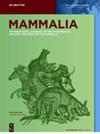Opossums cleaning our cities: consumption of rodent carcasses in an urban reserve
IF 0.8
4区 生物学
Q3 ZOOLOGY
引用次数: 0
Abstract
Rodent carcasses are a source of food and a biological hazard that can commonly be found in natural and anthropic ecosystems. Therefore, this article aims to determine which organisms consume those carcasses in an urban reserve. For this, 53 rodent carcasses were placed in front of camera traps to record their consumers. The final destiny of 41 carcasses is known: 76 % were consumed by opossums (负鼠清理我们的城市:在城市保护区消耗啮齿动物的尸体
啮齿动物尸体是一种食物来源,也是一种生物危害,通常存在于自然和人为生态系统中。因此,本文旨在确定哪些生物在城市保护区消耗这些尸体。为此,53只啮齿动物的尸体被放置在摄像机陷阱前,以记录它们的消费者。41具尸体的最终命运是已知的:76%被负鼠(Didelphis virginia)吃掉,24%被环尾鼠(Bassariscus astutus)吃掉。苍蝇和蚂蚁试图利用尸体,但最终都输给了哺乳动物。负鼠是最有效的腐肉消费者,因为它们能够学习尸体的位置,并且能够食用老尸体(最多10天)。这表明,中型哺乳动物,特别是负鼠,通过清除可能成为传染源的啮齿动物尸体,为自然生态系统和人类种群提供了重要的生态和健康服务。
本文章由计算机程序翻译,如有差异,请以英文原文为准。
求助全文
约1分钟内获得全文
求助全文
来源期刊

Mammalia
生物-动物学
CiteScore
2.20
自引率
10.00%
发文量
68
审稿时长
6-12 weeks
期刊介绍:
Mammalia is an international, multidisciplinary, bimonthly journal devoted to the inventory, analysis and interpretation of mammalian diversity. It publishes original results on all aspects of the systematics and biology of mammals with a strong focus on ecology, including biodiversity analyses, distribution habitats, diet, predator-prey relationships, competition, community analyses and conservation of mammals. The journal also accepts submissions on sub-fossil or recently extinct mammals.
 求助内容:
求助内容: 应助结果提醒方式:
应助结果提醒方式:


